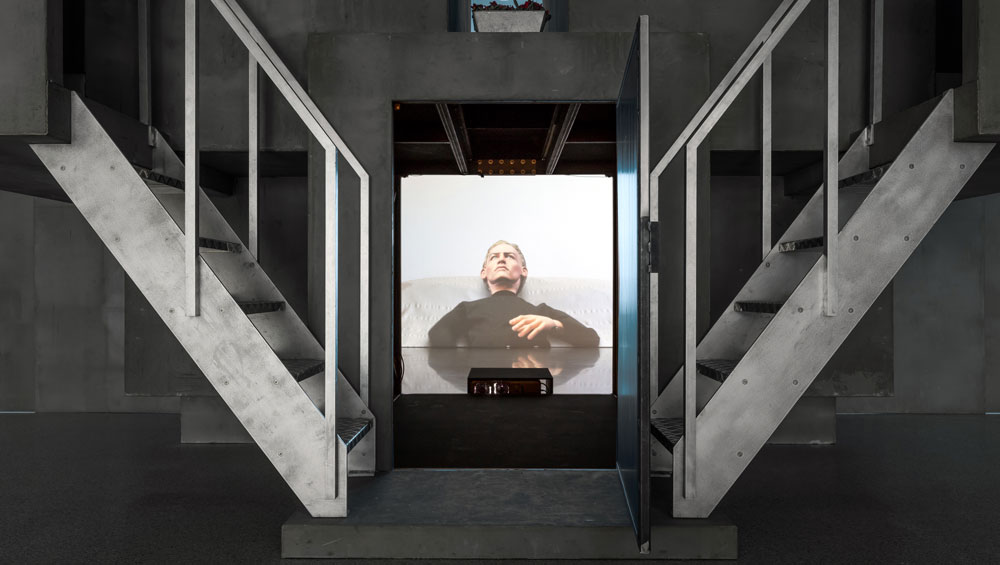
Mumok, Vienna
23 March – 1 July 2018
by LISA MORAVEC
In the basement of the Mumok, Vienna’s Museum of Modern Art, Cécile B Evans’s video installation Amos’ World (2017), her first solo museum show in Austria, fills the one-room space that is devoted to the works of emerging and mid-career artists. The video, which has previously been exhibited at Art Basel by Viennese Galerie Emanuel Layr (2017) and at the Castello di Rivoli in Turin (2016), takes the form of a TV programme about Amos, a man portrayed in the work’s description as a cross between Saint-Exupéry’s Little Prince and a brutalistic architect, and his plans to build a utopian apartment block. Evans has added an architectural installation that faces the projection of Amos’ World and together they inhabit one half of the white-cube-like space, while the other half of the space is empty apart from a bright-blue installation piece that hangs on the short wall.
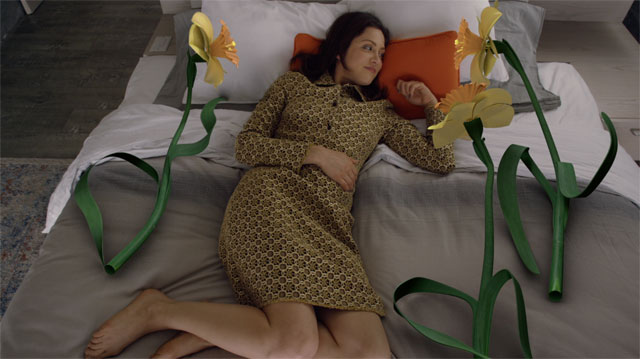
Cécile B. Evans. Amos’ World, 2017. Video still: Amos’ World: Episode One. Courtesy of the artist and Galerie Emanuel Layr, Vienna/Rome.
To view the video, which is cut off from the rest of the space by an impenetrable wall, it is necessary to climb either of the two short flights of stairs in Evans’s two-storey brutalist-style installation and enter one of five completely dark cubes, inside which there is room only to kneel or sit. The size of the cubes makes the idea of sharing one with someone else to watch the 25-minute video almost unthinkable. The result was a viewing experience that made me feel lonely and isolated, sealed off not only from the museum, but also from the outside world.
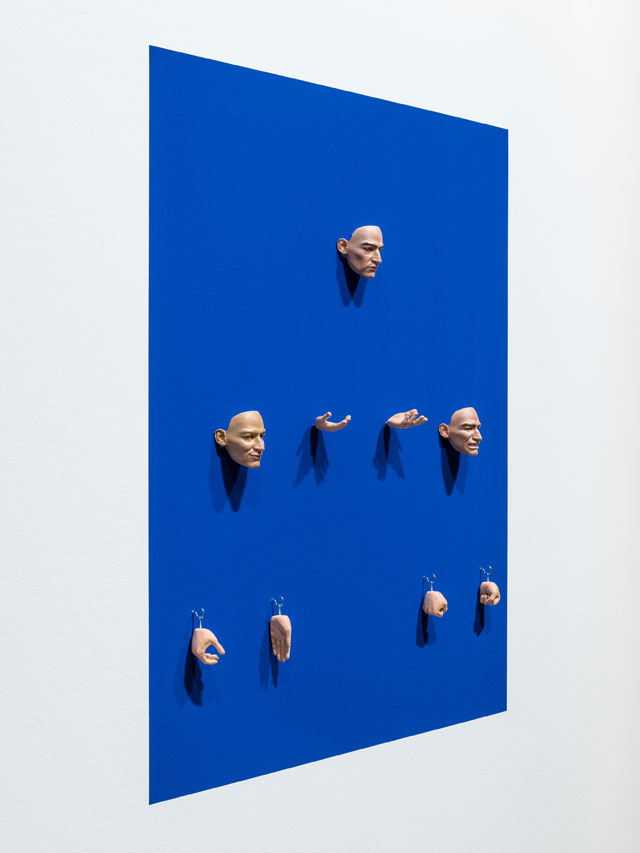
Cécile B. Evans. Amos’ World, 2017: Episode One. Exhibition view, mumok, 2018. © mumok. Photograph: Klaus Pichler.
Generating such uncomfortable, negative emotions is perhaps what Evans intended, as these feelings – like the architectural installation itself – echo the content of the video. In her work, the Belgian-American artist (b1983) is concerned with emotions and the impact digital technology has on them in today’s society. In this sense, the exhibition is an expansion of her previous projects, which have focused on digital social networks and artificial intelligence.1 This becomes clear at the beginning of the video, when Amos, represented as a white hand puppet with a computer-generated-imagery face, says: “How do I do it. I try to think about what I want. I want to build something important. That’s not right. I want to change the world. That sounds wrong to say it out loud. I want to express myself. I can’t find the words. I draw a line from where I am feeling to what I want. Where I want things to be. And that’s my plan. I don’t know what the plan is.”
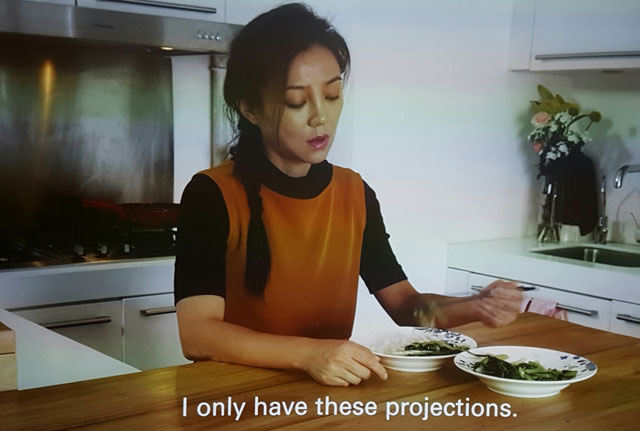
Cécile B. Evans. Amos’ World, 2017. Video still: Amos’ World: Episode One. Courtesy of the artist and Galerie Emanuel Layr, Vienna/Rome.
His plan, we learn later, concerns the construction of his housing project, which, it becomes clear, got built but was not a success. The fictional character of Amos is based on a composite of many figures and projects, mainly architects and brutalist complexes – including le Vele di Scampia, Il Corviale and Pruitt-Igo. Several of his lines are taken from the writings of Le Corbusier and interviews with brutalist architects, among others Peter Smithson, who, with his wife Alison, was responsible for the construction of the social housing complex Robin Hood Gardens in London, completed in 1972 at a cost of almost £2m.2 Architecturally, the Smithsons – like Evans herself – were inspired by Le Corbusier’s multiple constructions of his Unité d’Habitation in several countries. Its Berlin version became a listed building in the mid-1990s, while demolition began last year on Robin Hood Gardens.3
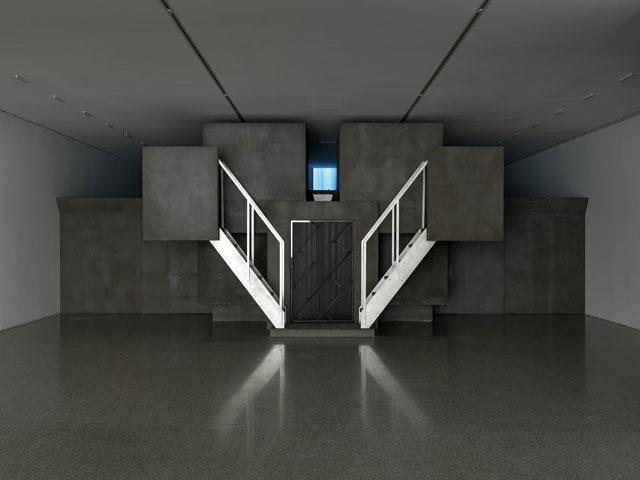
Cécile B. Evans. Amos’ World, 2017: Episode One. Exhibition view, mumok, 2018. © mumok. Photograph: Klaus Pichler.
Evans’s work, however, only marginally references a fraction of the European history of modern and postwar architecture with her Mumok show. The core of the exhibition is the video piece since it constructs its own artificial infrastructure, made up of digital images and voices through collaborative social relationships. Apart from the architect and The Weather, we hear from The Secretary, Gloria, A Voice and A Time Traveller as Amos is forced to face the tenants – in a way echoing what happened at Robin Hood Gardens, where structural inadequacies and years of social problems led to a questioning of the architects’ ideology behind the social housing complex. In the video, we get a more detailed insight into the lives of two of the tenants of Amos’ block: through their monologues, we get to know Gloria, a Chinese actor living with her disembodied mother, who is said not to have left the building since the last food restocking, and The Secretary, a woman in her 30s, who was joined temporarily in her single unit by three teenage flowers, The Nargis, until they ran away.
The character and the 3D mask of the architect relate to Evans’s previous preoccupation with the relationship between technology, artificial intelligence, architecture and emotions. The three facial expressions of the architect and the accompanying three hand gestures are exhibited on the blue installation on the opposite wall. While her work blends all these themes, the acting style of the depicted characters significantly adds weight to the video piece – it is no surprise that Evans trained in acting at the renowned New York University Tisch School of the Arts before becoming a visual artist.
The Chinese actor appears to look into a void while talking and although The Secretary does look directly at the camera, her voice is partially disembodied and it is hard to tell who she is addressing. There is a sense that they do not connect with us, the viewers, creating a critical distance akin to Brecht’s alienation effect (Verfremdungseffekt), and opening up the possibility for us to reflect on Evans’s work from a dissociated, unemotional point of view. Since we can exist and enter the installation and the exhibition space any time we want, the work neither demands from us or draws us to watch the whole episode inside the museum space. We can choose how long we want to engage with Evans’s multilayered first episode of Amos’ World while sitting inside a social unit, alias black cube, made for this museum space.
References
1. Roxanne Bagheshirin Lærkesen interviews Evans at her studio in London, February 2016, available at: http://channel.louisiana.dk/video/cecile-b-evans-virtual-real
2. For more on the New Brutalism movement read: https://www.architectural-review.com/rethink/viewpoints/the-new-brutalism-by-reyner-banham/8603840.article
3. In Pictures: Robin Hood Gardens’ Demolition Begins, The Architects’ Journal, 7 September 2017.